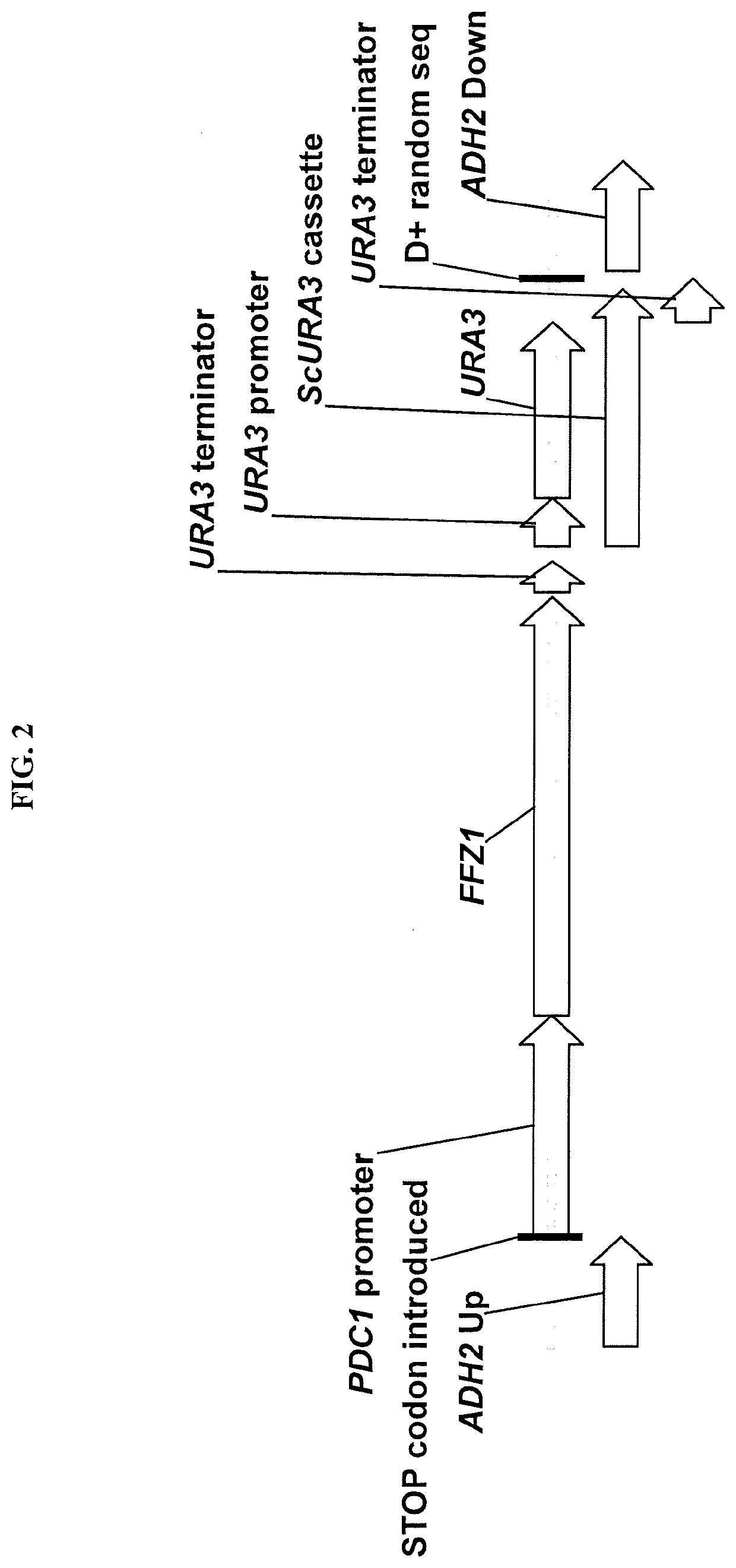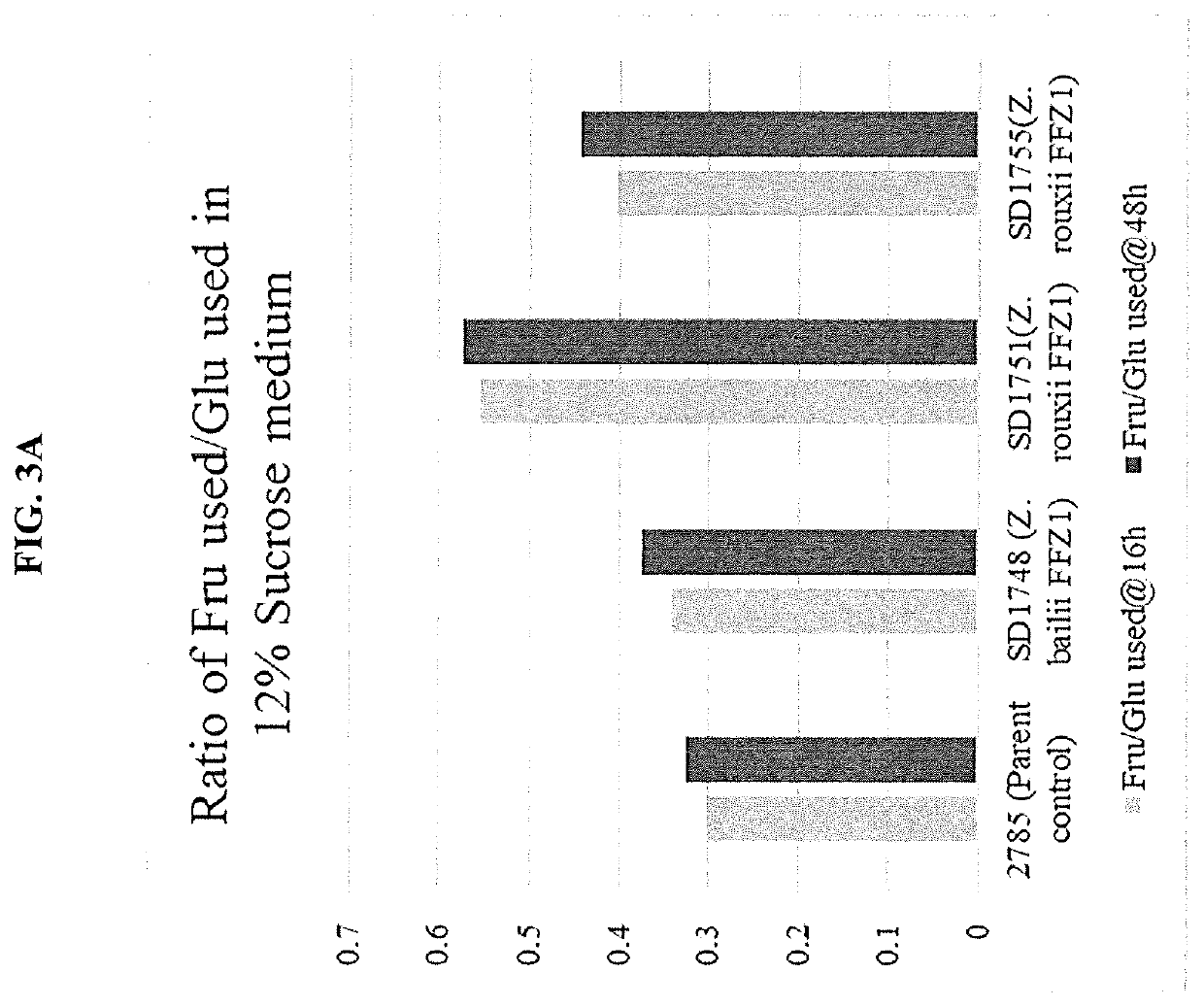Microbial strains engineered for improved fructose utilization
a technology of genetic engineering and microorganisms, applied in the field of genetic engineering of microorganisms, can solve the problems of unsatisfactory fructose utilization rate, difficult to remove undesirable yellow- and brown-colored compounds, waste of carbon in residual fructose, etc., and achieves a more complete utilization rate of fructose, short fermentation time, and increased fructose utilization rate
- Summary
- Abstract
- Description
- Claims
- Application Information
AI Technical Summary
Benefits of technology
Problems solved by technology
Method used
Image
Examples
example 2
ion of a Transformable Low Pyruvate D-Lactate Producing Yeast
[0087]SD1566 is an engineered derivative of a Crabtree positive strain of Kluyveromyces marxiamus that contains three integrated copies of a cassette designed to express the E. coli ldhA (EcldhA) gene. The construction and genesis of SD1566 has been described in US patent application 62-631,541, the entirety of which is hereby incorporated by reference. In SD1566, the three EcldhA cassettes are inserted at the KmPDC1, KmGPP1, and KmNDE1 loci. In all three cases, the EcldhA gene is driven by the KmPDC1 promoter, but no chromosomal sequences were deleted. SD1555, a precursor of SD1566, contained a fourth copy of EcldhA inserted at the KmPCK1 locus, but during the selection for resistance to beta-chlorolactate, which gave rise to SD1566, a spontaneous deletion of the entire KmPCK1 locus and surrounding DNA occurred, leaving SD1566 with a pck1− phenotype, which is the lack of ability to perform gluconeogenesis. Another phenoty...
example 3
ion of First Generation FFZ1 Expression Cassettes in D-Lactate Producing Yeasts
[0091]The FFZ1 gene from either Zygosaccharomyces bailii or Zygosaccharomyces rouxii was expressed by homologous integration at a genomic locus on Chromosome 4 such that the native KmADH2 gene at that locus was disrupted. The integration cassettes comprised of 1) “ADH2 up”, 501 bp DNA corresponding to the coding sequence of 1 to 501 of the native ADH2 ORF, 2) a TAA stop codon which should act as a translational stop codon to terminate translation of the partial ADH2 ORF, 3) a 1000 bp sequence containing the KmPDC1 promoter, 4) the ZbFFZ1 ORF (open reading frame) or the ZrTFZ1 ORF from Zygosaccharomyces balii or Zygosaccharomyces rouxii, respectively, 5) a ScURA3 cassette comprising of a modified Saccharomyces cerevisiae URA3 gene terminator sequence placed both upstream and downstream of a Saccharomyces cerevisiae URA3 promoter and ORF, 6) “D+”, a synthetic DNA sequence of 22 bp (AACTTAGACTAAGGAGGTTTGG), ...
example 4
ion of KMS1017, an L-Lactate Producer, and KMS1019, its Ura3-Derivative Suitable for Further Engineering
[0097]Plasmid pMS155, which was designed to contain a cassette for exchanging the PaldhL open reading frame for the EcldhA open reading frame at any of the integrated cassettes in any of the D-lactate producer strains, was constructed using the NEBuilder HiFi Assembler Cloning Kit (see FIG. 4 and SEQ ID No. 5). The PaldhL swap cassette was amplified by PCR from pMS155 and transformed into SD1774, selecting for URA3+ transformants. URA3+ colonies were then tested by colony PCR to determine which of the three copies of the EcldhA gene had been replaced. Strain KMS977 was shown to have the copy at the GPP1 locus replaced. The URA3 gene in KMS977 was then deleted by homologous recombination and selection on medium containing 5′-FOA, producing KMS984. KMS984 was subsequently transformed with the same swap cassette, this time replacing EcldhA at the NDE1 locus to give KMS1001. The URA3 ...
PUM
| Property | Measurement | Unit |
|---|---|---|
| Length | aaaaa | aaaaa |
| Strain point | aaaaa | aaaaa |
Abstract
Description
Claims
Application Information
 Login to View More
Login to View More - R&D
- Intellectual Property
- Life Sciences
- Materials
- Tech Scout
- Unparalleled Data Quality
- Higher Quality Content
- 60% Fewer Hallucinations
Browse by: Latest US Patents, China's latest patents, Technical Efficacy Thesaurus, Application Domain, Technology Topic, Popular Technical Reports.
© 2025 PatSnap. All rights reserved.Legal|Privacy policy|Modern Slavery Act Transparency Statement|Sitemap|About US| Contact US: help@patsnap.com



